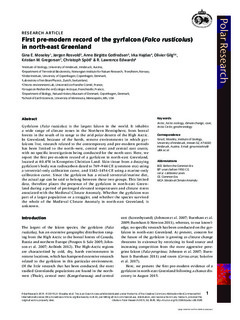First pre-modern record of the gyrfalcon (Falco rusticolus) in north-east Greenland
Moseley, Gina E.; Rosvold, Jørgen; Gotfredsen, Anne Birgitte; Hajdas, Irka; Gilg, Olivier; Gregersen, Kristian M.; Spötl, Christoph; Edwards, Lawrence
Journal article, Peer reviewed
Published version

Åpne
Permanent lenke
http://hdl.handle.net/11250/2632564Utgivelsesdato
2019Metadata
Vis full innførselSamlinger
- Publikasjoner fra CRIStin - NINA [2364]
- Scientific publications [1392]
Originalversjon
10.33265/polar.v38.3539Sammendrag
Gyrfalcon (Falco rusticolus) is the largest falcon in the world. It inhabits a wide range of climate zones in the Northern Hemisphere, from boreal forests in the south of its range to the arid polar deserts of the High Arctic. In Greenland, because of the harsh, remote environments in which gyrfalcons live, research related to the contemporary and pre-modern periods has been limited to the north-west, central west and central east coasts, with no specific investigations being conducted for the north-east. Here, we report the first pre-modern record of a gyrfalcon in north-east Greenland, located at 80.4°N in Kronprins Christian Land. Skin tissue from a decaying gyrfalcon’s body was radiocarbon dated to 769–944 CE (common era) using a terrestrial-only calibration curve, and 1182–1456 CE using a marine-only calibration curve. Since the gyrfalcon has a mixed terrestrial/marine diet, the actual age can be said to belong between these two groups. This Limited data, therefore places the presence of the gyrfalcon in north-east Greenland during a period of prolonged elevated temperatures and climate stress associated with the Medieval Climate Anomaly. Whether the gyrfalcon was part of a larger population or a straggler, and whether the species survived the whole of the Medieval Climate Anomaly in north-east Greenland, is unknown. Arctic; Arctic ecology; climate change; cave; Arctic Circle; geochronology
